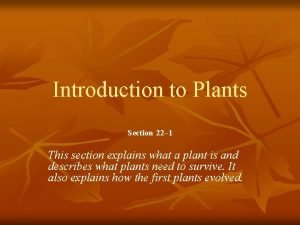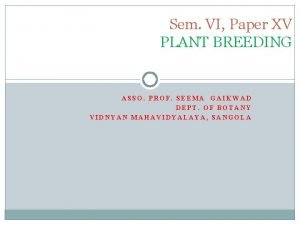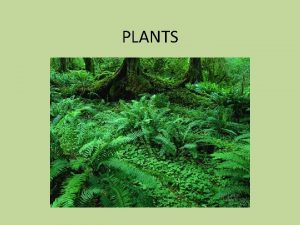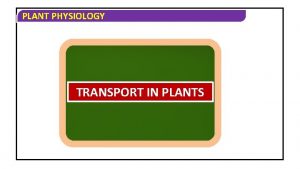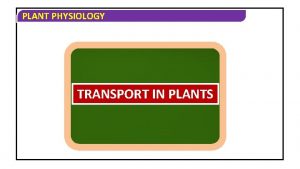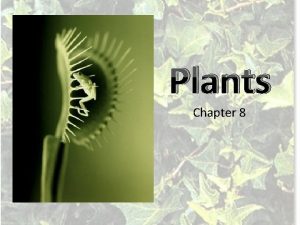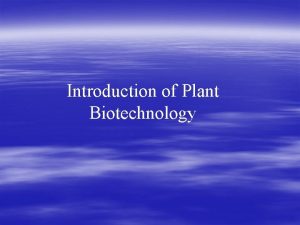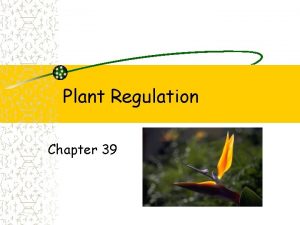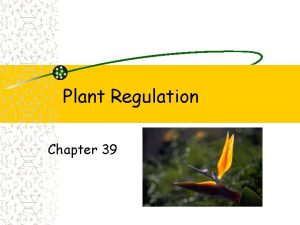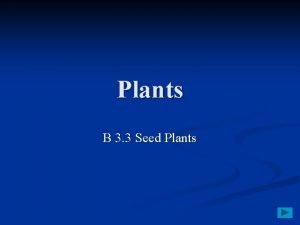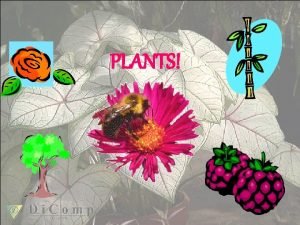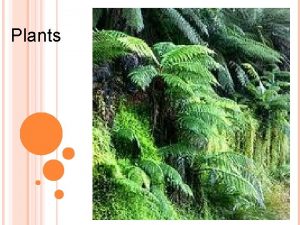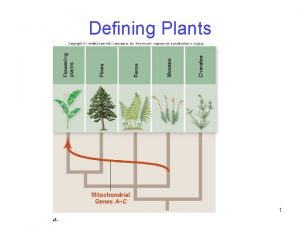Chapter 21 Introduction to Plants 21 1 Plant
























- Slides: 24

Chapter 21 Introduction to Plants 21. 1 Plant Evolution and Adaptations § When scientists compare present-day plants and present-day green algae, they find the following common characteristics: § cell walls composed of cellulose § cell division that includes the formation of a cell plate § the same type of chlorophyll used in photosynthesis § similar genes for ribosomal RNA § food stored as starch § the same types of enzymes in cellular vesicles

Chapter 21 Introduction to Plants 21. 1 Plant Evolution and Adaptations Cuticle § Helps prevent the evaporation of water from plant tissues § Acts as a barrier to invading microorganisms

Chapter 21 Introduction to Plants 21. 1 Plant Evolution and Adaptations Stomata § Adaptations that enable the exchange of gases even with the presence of a cuticle on a plant § Openings in the outer cell layer of leaves and some stems

Chapter 21 Introduction to Plants 21. 1 Plant Evolution and Adaptations Vascular Tissues § Vascular tissue enables faster movement of substances than by osmosis and diffusion, and over greater distances. § Vascular tissue provides support and structure, so vascular plants can grow larger than nonvascular plants.

Chapter 21 Introduction to Plants 21. 1 Plant Evolution and Adaptations Seeds § A plant structure that contains an embryo, contains nutrients for the embryo, and is covered with a protective coat § These features enable seeds to survive harsh environmental conditions and then sprout when favorable conditions exist.

Chapter 21 Introduction to Plants 21. 1 Plant Evolution and Adaptations Alternation of Generations § Gametophyte generation produces gametes. § Sporophyte generation produces spores that can grow to form the next gametophyte generation.

Chapter 21 Introduction to Plants 21. 2 Nonvascular Plants Diversity of Nonvascular Plants § Division Bryophyta § Most familiar bryophytes are the mosses. § Structures that are similar to leaves Carpet of moss Leafy stems Rhizoids

Chapter 21 Introduction to Plants 21. 2 Nonvascular Plants § Produce rootlike, multicellular rhizoids that anchor them to soil or another surface § Water and other substances move throughout a moss by osmosis and diffusion.

Chapter 21 Introduction to Plants 21. 2 Nonvascular Plants Division Anthocerophyta § Anthocerophytes are called hornworts. § Water, nutrients, and other substances move in hornworts by osmosis and diffusion. Hornwort

Chapter 21 Introduction to Plants 21. 2 Nonvascular Plants Identifying Features § One large chloroplast in each cell of the gametophyte and sporophyte § Spaces around cells are filled with mucilage, or slime. § Cyanobacteria grow in this slime.

Chapter 21 Introduction to Plants 21. 2 Nonvascular Plants Division Hepaticophyta § Hepaticophytes are referred to as liverworts. § Found in a variety of habitats § Water, nutrients, and other substances are transported by osmosis and diffusion.

Chapter 21 Introduction to Plants 21. 2 Nonvascular Plants § Most primitive of land plants Leafy liverwort Thallose liverwort

Chapter 21 Introduction to Plants 21. 3 Seedless Vascular Plants Diversity of Seedless Vascular Plants § Division Lycophyta § Sporophyte generation of lycophytes is dominant. § Reproductive Lycopodium—wolf’s claw structures produce spores that are club-shaped or spike-shaped.

Chapter 21 Introduction to Plants 21. 3 Seedless Vascular Plants § Have roots, stems, and small, scaly, leaflike structures § Two genera—Lycopodium and Selanginella

Chapter 21 Introduction to Plants 21. 3 Seedless Vascular Plants Division Pterophyta § Plant division includes ferns and horsetails Aquatic fern Staghorn fern Hawaiian fern Dryopteris

Chapter 21 Introduction to Plants 21. 3 Seedless Vascular Plants § Sporophyte produces roots and a thick underground stem called a rhizome, a food-storage organ. § The frond is part of the sporophyte generation of ferns.

Chapter 21 Introduction to Plants 21. 3 Seedless Vascular Plants § Fern spores form in a structure called a sporangium. § Clusters of sporangia form a sorus. § Sori usually are located on the undersides of fronds. Bird’s nest fern

Chapter 21 Introduction to Plants 21. 4 Vascular Seed Plants Diversity of Seed Plants § A variety of adaptations for the dispersal or scattering of their seeds throughout their environment § The sporophyte is dominant in seed plants and produces spores. Cocklebur Pine seed Witch hazel

Chapter 21 Introduction to Plants 21. 4 Vascular Seed Plants Division Cycadophyta § Cones contain male or female reproductive structures of cycads and other gymnosperm plants. § Evolved before plants with flowers § The natural habitats for cycads are the tropics or subtropics.

Chapter 21 Introduction to Plants 21. 4 Vascular Seed Plants Division Gnetophyta § Can live as long as 1500– 2000 years § Three genera of gnetophytes § Ephedrine is a compound found naturally in gnetophytes. Welwitschia

Chapter 21 Introduction to Plants 21. 4 Vascular Seed Plants Division Ginkgophyta § Only one living species, Ginkgo biloba § Has small, fan-shaped leaves Male § Male and female reproductive systems are on separate plants Female

Chapter 21 Introduction to Plants 21. 4 Vascular Seed Plants Division Coniferophyta § Reproductive structures of most conifers develop in cones. § Male and female cones on different branches § Waxlike coating called cutin reduces water loss. Douglas fir—woody cones Juniper—berrylike cones Pacific yew—fleshy cones

Chapter 21 Introduction to Plants 21. 4 Vascular Seed Plants Division Anthophyta § First appeared in the fossil record about 130 million years ago § Botanists classify anthophytes as monocots, dicots, or eudicots.

Chapter 21 Introduction to Plants 21. 4 Vascular Seed Plants § A biennial plant’s life spans two years. § Perennial plants can live for several years and usually produce flowers and seeds yearly. First-year growth Knocking Out Genes Second-year growth
 Define plant breeding
Define plant breeding Plant introduction in plant breeding
Plant introduction in plant breeding Plant introduction in plant breeding
Plant introduction in plant breeding Chapter 22 introduction to plants worksheet answers
Chapter 22 introduction to plants worksheet answers Vascular plants vs nonvascular plants
Vascular plants vs nonvascular plants Nonvascular plant diagram
Nonvascular plant diagram Classify flowering and nonflowering plants
Classify flowering and nonflowering plants Photosynthesis equation
Photosynthesis equation Unit 2 plant taxonomy how plants are named
Unit 2 plant taxonomy how plants are named Tronsmo plant pathology and plant diseases download
Tronsmo plant pathology and plant diseases download Tronsmo plant pathology and plant diseases download
Tronsmo plant pathology and plant diseases download Tronsmo plant pathology and plant diseases download
Tronsmo plant pathology and plant diseases download Algae in a sentence
Algae in a sentence What is plant layout and its objectives
What is plant layout and its objectives Objectives of layout
Objectives of layout Functional plant layout
Functional plant layout Breeding objectives of wheat
Breeding objectives of wheat Water hammer effect in hydro power plant
Water hammer effect in hydro power plant Chapter 25 plant responses and adaptations
Chapter 25 plant responses and adaptations Chapter 22 plant diversity
Chapter 22 plant diversity Chapter 25 plant responses and adaptations
Chapter 25 plant responses and adaptations Chapter 22 plant diversity answer key
Chapter 22 plant diversity answer key Chapter 21 section 1 plant evolution and adaptations
Chapter 21 section 1 plant evolution and adaptations Chapter 10 property plant and equipment
Chapter 10 property plant and equipment Chapter 22 plant structure and function answer key
Chapter 22 plant structure and function answer key












